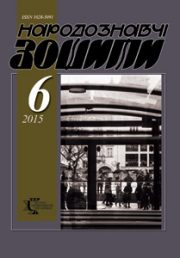The Ethnology Notebooks. 2024. № 6 (180), 1515—1531
UDK 745.52.077(477.86)
DOI https://doi.org/10.15407/nz2024.06.1515
MASTERS OF FOLK WEAVING OF THE VILLAGE KORNYCH ІN POKUTTIA: BETWEEN AUTHENTICITY AND IMITATION
OLIYNYK Olha
- ORCID ID: https://orcid.org/0000-0002-7292-3264
- Сandidate of Аrts (Ph.D), Researcher at the Folk,
- Art Department of Ethnology Institute
- of the National Academy of Sciences of Ukraine,
- 15, Svobody Avenue, 79000, Lviv, Ukraine,
- Contacts: e-mail: oliao1610mac@gmail.com
Abstract. Introduction. Today, more than ever, the arguments regarding the preservation of ancient monuments and the study of the work of folk masters by both academics and amateurs in the field are more relevant. In this context, it is important to analyze the creativity of the masters of a separate center of folk weaving in the village of Kornych (Kolomiya district, Ivano-Frankivsk region).
Article purpose is to highlight the life and creative path of folk weaving masters Ivan Antonyuk and Kateryna Romanenchuk, who developed the traditions of folk weaving at the end of the 20th and 21st centuries, in the context of the history of the development of the Kornych weaving center; it is relevant to note the role of the individual in the revival of the center and the preservation of ethno-cultural values.
The object of the research is the historical and cultural aspects of the functioning of the Kornych weaving center, and the subject is the artistic practice and works of prominent weavers — Ivan Antonyuk and Kateryna Romanenchuk.
The article source base was made up of recordings of an interview with master Ivan Antoniuk, made by the author in 1992 during a field study of the Kornych weaving center; correspondence with modern craftswoman Kateryna Romanenchuk, works of weavers of the Kornyсh, and her collection of works, as well as historical and local literature, Internet resources, archival materials. The largest collection of traditional fabrics from Kornych and neighboring villages, related by the same tradition, is owned by National Museum of Folk Art of Hutsul region and Pokuttia.
The research used methods of information collection (interviews, observations, and photography); the biographical method is used to highlight events from the life and work of masters, to identify the influence of socio-economic and personal factors on them. Using the method of art analysis, the creative heritage of past and present masters was evaluated, and its significance for Ukrainian culture was clarified.
Conclusion. The conducted research gives grounds for asserting that the ancient center of weaving in Kornych is a notable phenomenon in the folk art of Pokuttia and Ukrainian traditional culture. Primary merit in its revival and preservation until the end of the 20th century belongs to folk master Ivan Antoniuk. Ivan Antoniuk’s work became a signpost on the way to the establishment of the deep traditions of Pokuttia and served for the growth of a new generation of Kornych weavers, among whom today the figure of folk craftswoman Kateryna is noticeable.
The creative practices of Kornych masters, as well as the culturally representative events of local enthusiasts, are a convincing argument for the continuation and nurturing of the tradition of Kornych.
Keywords: folk weaving, Pokuttia, Kornych settlement, tradition, master, artwork, composition, ornament, pattern, color.
Received 13.11.2024
REFERENCES
- Oliynyk, O.V. (1997). Traditional artistic textiles of the late 19th and mid-20th centuries: diss. … candidate of arts: 17.00.06. Lviv: Institute of National Academy of Sciences of Ukraine [in Ukrainian].
- Oliynyk, O. (2017). Folk weaving Pokuttia: tradition and modernity. Ethnology notebooks, 2, 251—257 [in Ukrainian].
- Oliynyk, O. (2018). Weaving of Pokuttia of the late ХХ and the early XXI centuries: tradition and figurative-style inspirations. Ethnology notebooks, 2, 441—447 [in Ukrainian].
- Nykorak, O. (2004). The Ukrainian tradition folk cloth of the 19th and 20th cc.: Typology, spreading, artistic features. Interior fabrics (based on materials from Western regions of Ukraine) (Part I). Lviv: IЕ NAS of Ukraine [in Ukrainian].
- Nykorak, O. (2023). The Ukrainian tradition folk cloth of the 19th and 20th cc.: Typology, spreading, artistic features. Clothing fabrics (based on materials from Western regions of Ukraine) (Part II). Lviv: IЕ NAS of Ukraine [in Ukrainian].
- Town and country records, 3581 (Vol. 12, p. 348) [in Polish].
- Lviv Scientific Library of the National Academy of Sciences. Department of Manuscripts. F. Yablonovsky, 78 (d) [in Polish].
- Gerasimovych, I. (1886). Fairs and auctions in Pokutta. Work, 90 [in Ukrainian].
- (1989). Penitential motifs: Catalog of the exhibition I. Antoniuk. Iv.-Frankivsk [in Ukrainian].
- Tkachuk, Ya. (1991, february 8). We have been weaving for seven years. Herald of Kolomyia [in Ukrainian].
- Savchuk, M. (1993, june 19). Towels that breathe in autumn. Оmniscience. Kolomyia [in Ukrainian].
- Krechkovsky, L.V. (2001). Antoniuk Ivan Vasyliovych. Encyclopedia of Modern Ukraine. Kyiv: Institute of Encyclopedic Research of the National Academy of Sciences of Ukraine. Retrieved from: https://esu.com.ua/article-43030 (Last accessed: 12.11.2024) [in Ukrainian].
- Guardian of Pokut traditions. Retrieved from: https://hutsul.museum/events/2020/kateryna_romanenchuk/ (Last accessed: 12.11.2024) [in Ukrainian].
- Hrytsak, N. «Textile. Dynamics of tradition». Retrieved from: http://hutsul.museum/exhibitions/2013/Tekstul-dynamika-traduciya/ (Last accessed: 12.11.2024) [in Ukrainian].
- Hrytsak, N. «Handmade fabric» by Kateryna Romanenchuk. Retrieved from: https://hutsul.museum/exhibitions/2023/rukotvorna-tkanyna-kateryny-romanenchuk/ (Last accessed: 12.11.2024) [in Ukrainian].
- July 8, 2024 — «The past is the true truth about us»: how a furrier from the Kolomiysk region, Mykhaylo Vintonyuk, is reviving an ancient craft and a connection with his ancestors (PHOTOS). Retrieved from: https://galka.if.ua/mynule-to-istynna-pravda-pro-nas-iak-kushnir-z-kolomyyshchyny-mykhaylo-vintoniuk-vidrodzhuie-davnie-remeslo-i-zv-iazok-z-predkamy-foto/?fbclid=IwY2xjawF4gqhleHRuA2FlbQIxMQABHeV90BLecAzwC_ytWShJfmFNn-tG1q7qoqcUXePvqQscoWoEHCY8G9TENQ_aem_iinHHPmE061KVCeqMPox4Q (Last accessed: 12.11.2024) [in Ukrainian].







